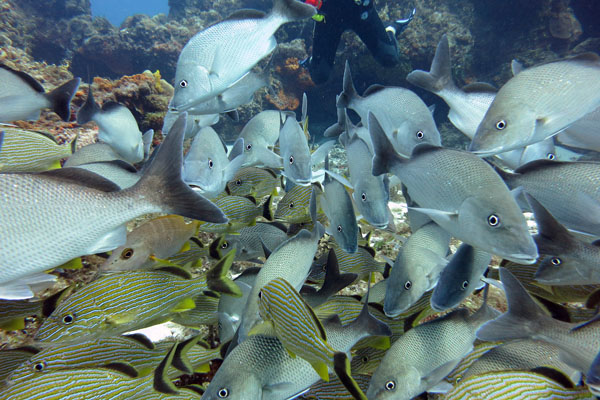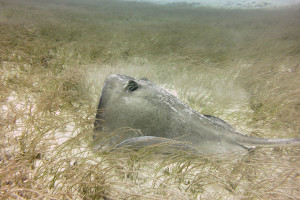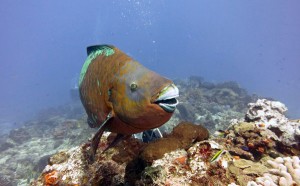News
Capturing great underwater photos using natural light with Kim Coleman

Taking underwater photos with only natural light can be extremely difficult. There are many factors involved with getting good images, the most obvious being good overhead sunlight, clear water with good visibility and no particles causing backscatter of light. There is the colour of the water to consider, the depth in which you are taking the photos, the distance of your subject, and so on. But with patience and a little effort, good quality photos are very achievable – and you don’t need really expensive cameras to do it.
 I recently joined a dive trip to the Yucatan in Mexico organised by John Spencer-Ades from The Scuba Place. Throughout our time there visiting many different dive sites, Kim Coleman quietly took photos with her Cannon S110 compact in a Nauticam NA-S110 housing and it was not until towards the end of the trip that I asked to see some of her photos. As I looked through an impressive selection it dawned on me that she had taken all the photos with natural available light and was using no flash at all.
I recently joined a dive trip to the Yucatan in Mexico organised by John Spencer-Ades from The Scuba Place. Throughout our time there visiting many different dive sites, Kim Coleman quietly took photos with her Cannon S110 compact in a Nauticam NA-S110 housing and it was not until towards the end of the trip that I asked to see some of her photos. As I looked through an impressive selection it dawned on me that she had taken all the photos with natural available light and was using no flash at all.
I asked her to tell me about the techniques she was using…
Kim: Before this trip I had always used the auto setting on my camera and was never completely satisfied with the results. Often the exposure was too bright and many of my photos had a wishy washy look to them. Then a friend took time to show me and explain about the manual settings on my camera. I began to explore the different settings for exposure, the different settings for aperture and shutter speed priority as well as changing the ISO settings. I thought it would be hard, but after playing with the camera in my kitchen I soon got the hang of taking control of how I wanted my pictures to be exposed. There was a eureka moment when it all suddenly made sense.
Jeff: So this is the first trip where you have put into practice all you learnt at home?
Kim: Yes. I feel much more confident now about making the camera do what I want.
Jeff: But there is more to your photos than just good exposure; the composition and framing is excellent, as is the feeling of action and life.
 Kim: As the quality of my photos is getting better so I have the confidence to take more time over each shot. I think now about perspective on subjects and work at getting my position right with what ever I am photographing. Getting down to eye level is important as is being able to hold the camera steady for a sharp image. I now watch what’s going on around me, take my time and think about composition. Where as before I may have rushed to take a few shots on auto and been happy, now I will wait until everything is right before pressing the button.
Kim: As the quality of my photos is getting better so I have the confidence to take more time over each shot. I think now about perspective on subjects and work at getting my position right with what ever I am photographing. Getting down to eye level is important as is being able to hold the camera steady for a sharp image. I now watch what’s going on around me, take my time and think about composition. Where as before I may have rushed to take a few shots on auto and been happy, now I will wait until everything is right before pressing the button.
 Jeff: So are you diving differently now?
Jeff: So are you diving differently now?
Kim: Much slower, taking my time to look closely at all the incredible marine life and now I begin to notice all the individual behaviours of animals that I had simply missed before. My diving is much more relaxed.
Jeff: What’s next?
Kim: The main reason for me buying a camera was to take pictures to remember my dive holidays with and show them to my husband who doesn’t dive. But now I think I would like to do a course to learn more and print up some of my better photos to hang at home.
 Congratulations to Kim for exploring her camera and its capabilities beyond the auto settings. I am sure that having done this her diving experiences will move up a whole new level as she continues to develop her skills. Whether you are taking still photos or shooting video, being confident with your camera will produce great results and this in turn will lead to a new way of diving.
Congratulations to Kim for exploring her camera and its capabilities beyond the auto settings. I am sure that having done this her diving experiences will move up a whole new level as she continues to develop her skills. Whether you are taking still photos or shooting video, being confident with your camera will produce great results and this in turn will lead to a new way of diving.
Try to relax underwater; fish and other marine animals can tell if you are nervous or uncomfortable and so will stay away from you. Move slowly and deliberately. Breathe rhythmically and gently; explosive exhalation from your demand valve will make animals nervous. The most important skill is to get your buoyancy under control. Being too negative or positive in the water is exhausting and will make diving much harder than it need be. Neutral buoyancy diving is completely comfortable and helps immensely when taking photos.
Gear News
Introducing the TR-80, IR-50 and CS-30 Regulators from DYNAMICNORD

Whether you are a beginner or a professional diver – with the three new main regulators from DYNAMICNORD, everyone will find their favourite regulator. They all look super stylish.
Excellent performance with the TR-80
Quality and performance are the be-all and end-all for regulators. It is not for nothing that the TR stands for Tec Reg. The innovative design of the TR-80 guarantees absolute reliability – even in ice-cold waters.

Perfect breathing effort at 0.8 J/l / certified for diving in waters below 10 degrees / structural design made of solid brass for best cold protection / membrane-compensated design with dry seal of the first stage / reduced exhalation effort thanks to optimized exhalation membrane and bubble deflector / adjustable Venturi (dive/predive) and adjustment knob for individual inhalation comfort / innovative design of the front cover prevents free-flow in strong currents or when diving with scooters / design made of sandblasted brass, matt chrome finish / 2 HP and 4 LP outlets / mouthpiece made of high-quality, anti-allergic silicone for maximum comfort.


Amazing underwater adventures with the IR-50
The IR-50 is the top regulator for advanced and experienced divers. Natural breathing is the essence of this regulator.

Ideal breathing effort at 0.8 J/l /certified for diving in waters below 10 degrees / compensated membrane / adjustable venturi (dive/predive) and adjustment knob for individual inhalation comfort/ outlet valve and deflector for minimum exhalation effort and reduction of bubbles on the face / design made of sandblasted brass, matt chrome finish / 2 HP and 4 NP outlets / mouthpiece made of high-quality, anti-allergic silicone for maximum comfort.


The Workhorse – our CS-30
For diving centres and diving beginners – the workhorse stands for strong construction, reliability and robustness. Perfect for your training.

Optimal breathing effort at 0.8 J/l /recommended for diving in waters above 10 degrees / non-compensated piston / adjustable venturi (dive/predive) / outlet valve and deflector for minimum exhalation effort and reduction of bubbles on the face / design made of sandblasted brass, matt chrome finish / 1 HP and 3 NP outlets / mouthpiece made of high-quality, anti-allergic silicone for maximum comfort.


Octopus OP-30
The OP-30 is the ideal addition to all DYNAMICNORD regulators. It is identical in construction to the CS-30.

The TR-80, IR-50, CS-30 (DIN & INT) regulators and the Octopus OP-30 are available from DYNAMICNORD dealers and in the online store.
DYNAMICNORD – Your Outdoor Companion.
Marine Life & Conservation
Paul Watson Released as Denmark Blocks Japan’s Extradition Bid

Renowned anti-whaling activist Paul Watson has been released from custody in Greenland after spending five months in detention. Denmark’s Justice Ministry rejected Japan’s request for his extradition, citing insufficient guarantees that his time already served in custody would be credited against any potential sentence.
The 74-year-old Canadian-American was arrested on July 21 in Nuuk, Greenland’s capital, when his ship docked to refuel. His arrest was based on a 2012 Japanese warrant related to a 2010 encounter in Antarctic waters. Japan alleged Watson obstructed operations and caused damage to a whaling research ship during efforts to disrupt illegal whaling. Watson has consistently denied these claims, maintaining his commitment to marine conservation.
Denmark, which oversees extradition matters for Greenland, concluded that while the legal conditions for extradition were met, the lack of assurances from Japan regarding time-served credit made extradition untenable.
In a video shared by his foundation, Watson expressed gratitude and relief, saying, “After five months, it’s good to be out… and good to know they’re not sending me to Japan.” He added that the most difficult part of his time in custody was being separated from his two young sons.
Watson is a pioneering figure in marine conservation, known for founding the Captain Paul Watson Foundation in 2022 after decades of activism with the Sea Shepherd Conservation Society. His bold efforts to defend marine life have earned him widespread support, including from celebrities and conservationists. His work has also been featured in the acclaimed reality TV series Whale Wars.
Watson’s lawyer, Jonas Christoffersen, praised the decision, stating, “We are happy and relieved that Paul Watson is now free.” He added that Watson is eager to reunite with his family and continue his vital work.
The arrest occurred while Watson’s vessel, the M/Y John Paul DeJoria, was en route to the North Pacific with a team of 26 volunteers to intercept a Japanese whaling ship. His foundation described the arrest as politically motivated and emphasized that Watson’s actions were focused on ending illegal whaling practices.
Japan resumed commercial whaling in 2019 after leaving the International Whaling Commission, asserting that whale meat is a cultural tradition. Conservationists, however, continue to challenge these practices, highlighting their impact on marine ecosystems.
Despite the challenges, Watson remains steadfast in his mission to protect marine life and bring attention to whaling practices. His dedication to ocean conservation has made him a globally respected advocate for the environment.
-

 News2 months ago
News2 months agoIconic SS United States to become the World’s Largest Artificial Reef
-

 News3 months ago
News3 months agoBook Review – 52 Assignments: Underwater Photography
-

 Gear News3 months ago
Gear News3 months agoDYNAMICNORD – New German diving brand enters the British market
-

 News3 months ago
News3 months agoExploring Cenote El Pit: A Diver’s Dream
-

 Gear News3 months ago
Gear News3 months agoTry BARE drysuits (and maybe even win one!) this Friday with Sea & Sea at North West Dive Fest
-

 Marine Life & Conservation3 months ago
Marine Life & Conservation3 months agoBook Review: Coral Triangle Cameos
-

 Blogs2 months ago
Blogs2 months agoDive the Egyptian Red Sea this Autumn with Regaldive
-

 News3 months ago
News3 months ago2024 Ocean Art Underwater Photo Competition Announced


















